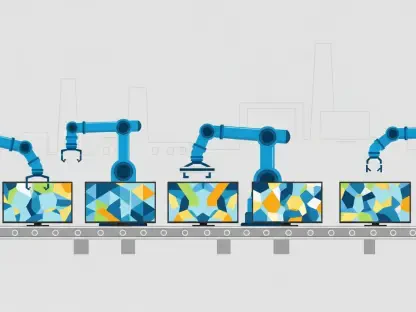In an era where the Internet of Things (IoT) continues to expand at an unprecedented pace, developers face mounting pressure to create solutions that perform efficiently on devices with limited resources, such as sensors and microcontrollers, while balancing robust functionality with minimal hardware demands. This challenge often seems out of reach with traditional web frameworks, but Microdot, an ultra-lightweight Python framework, redefines the boundaries of web development for constrained environments. Branded as “impossibly small,” this tool strips away the bloat of conventional frameworks while delivering essential features in just a few kilobytes. Its emergence signals a shift toward leaner, more sustainable software design, particularly for IoT applications where every byte counts. This innovative approach not only addresses technical limitations but also sparks curiosity about how minimalism can reshape modern development practices, offering a glimpse into a future where efficiency reigns supreme.
Redefining Minimalism in Web Development
Microdot stands out in the crowded landscape of web frameworks by prioritizing an ultra-compact design without sacrificing core capabilities. Tailored for environments where resources are scarce, it supports fundamental tasks like routing, request handling, and response generation while strictly adhering to HTTP protocols. The framework’s small footprint translates into faster load times and significantly reduced memory usage, making it a perfect fit for IoT devices and embedded systems where larger tools like Flask or Django simply cannot operate effectively. Beyond mere size, Microdot offers a straightforward API that simplifies the development process for newcomers while still providing enough depth for seasoned coders to customize as needed. This balance ensures that building web applications on minimal hardware becomes not just feasible but also efficient, opening doors to innovation in spaces where computational power is a precious commodity.
The appeal of Microdot extends beyond its diminutive size to its practical implications for developers working under tight constraints. By focusing on essential functionalities, it eliminates the overhead that often bogs down more comprehensive frameworks, allowing applications to run smoothly even on the most basic hardware. This efficiency is particularly critical in IoT scenarios, such as smart home devices or industrial sensors, where consistent performance can make or break a system’s reliability. Furthermore, the framework’s design philosophy encourages a mindset of resourcefulness, prompting developers to rethink how much complexity is truly necessary in their projects. As a result, Microdot not only serves as a technical tool but also as a catalyst for a broader cultural shift in software engineering, one that values simplicity and sustainability over unnecessary bulk in an increasingly connected world.
Technical Strengths and Adaptability
One of Microdot’s most compelling attributes lies in its dependency-free architecture, which leverages built-in Python features to maintain a lean and agile structure. This approach minimizes external requirements, ensuring that the framework remains lightweight and easy to deploy across diverse environments. Additionally, support for asynchronous programming through coroutines and event loops enhances its performance in high-concurrency situations, such as real-time APIs or microservices often found in IoT ecosystems. Middleware capabilities further allow for tailored customizations, enabling developers to integrate features like authentication or logging with minimal coding effort. Security remains a priority as well, with built-in safeguards against common web vulnerabilities, ensuring that even the smallest applications are protected from threats like cross-site scripting. Such robustness in a tiny package makes Microdot a standout choice for niche yet critical use cases.
Beyond its core design, Microdot’s adaptability positions it as a versatile solution for a range of modern development challenges. The compact codebase not only boosts performance but also reduces the potential attack surface, a significant advantage in sensitive sectors like healthcare or finance where data integrity is paramount. This focus on security, combined with the ability to scale functionality through custom middleware, means that developers can build tailored solutions without compromising safety or efficiency. Moreover, the framework’s compatibility with resource-constrained hardware ensures that it can power everything from simple hobbyist projects to complex industrial systems. As IoT continues to permeate various industries, Microdot’s ability to deliver reliable performance under tight limitations highlights its potential to become a go-to tool for developers seeking both innovation and practicality in their web application designs.
Market Position and Industry Impact
In the competitive realm of web development tools, Microdot carves a unique niche among lightweight Python frameworks, offering a compelling alternative to heavier ecosystems like Node.js-based Express.js. Its open-source nature fosters a collaborative environment where community contributions drive continuous improvement, fueling its growth among startups and independent developers who value rapid prototyping. However, challenges persist due to a relatively limited ecosystem compared to more established frameworks, often requiring custom integrations that may deter those accustomed to plug-and-play solutions. Despite this, Microdot’s emphasis on reducing computational waste aligns with growing environmental concerns in technology, enhancing its appeal to organizations prioritizing sustainability. This alignment with broader industry values positions the framework as a forward-thinking option in a market increasingly focused on efficiency.
The broader impact of Microdot reflects a noticeable trend toward minimalism in software design, challenging the notion that bigger always equates to better. Industry observers note its potential to influence development practices, especially in constrained environments where every resource must be optimized. Ongoing enhancements aim to improve scalability, potentially bridging the gap with larger frameworks over time. This trajectory suggests that Microdot could inspire a rethinking of how web applications are built, proving that compact tools can deliver substantial value without unnecessary overhead. As adoption grows, particularly among those experimenting with IoT innovations, the framework’s role in shaping sustainable and efficient coding practices becomes more evident. Its presence in the market underscores a pivotal shift, encouraging developers to embrace leaner solutions that meet modern demands with precision and purpose.
Pioneering Efficiency for Future Innovations
Reflecting on Microdot’s journey, it becomes evident that this tiny framework challenges long-standing assumptions about web development by proving that robust functionality can thrive within an ultra-small footprint. Its success in powering IoT and embedded systems with unparalleled efficiency sets a new benchmark for what developers can achieve under resource constraints. The open-source community’s enthusiasm plays a crucial role in refining its capabilities, while real-world applications demonstrate its practical value across diverse fields. Looking ahead, the focus should shift to expanding its ecosystem through collaborative efforts, ensuring that custom integrations become more accessible to a wider audience. Additionally, prioritizing scalability enhancements will be key to positioning Microdot as a viable option for larger projects. As the tech landscape evolves, embracing such minimalist tools offers a pathway to sustainable innovation, urging the industry to consider how efficiency can drive progress without excess.









